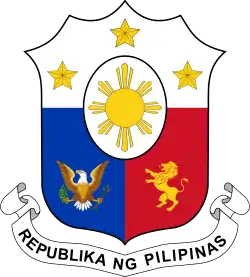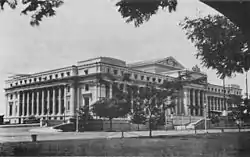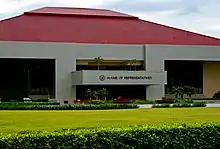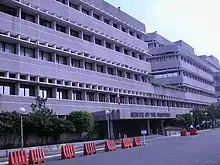Schurman Commission
The Schurman Commission, also known as the First Philippine Commission, was established by United States President William McKinley on January 20, 1899, and tasked to study the situation in the Philippines and make recommendations on how the U.S. should proceed after the sovereignty of the Philippines was ceded to the U.S. by Spain on December 10, 1898 following the Treaty of Paris of 1898.[1][2]

Its final report was submitted on January 3, 1900, and recommended the establishment of a civil government having a bicameral legislature and being financially independent from the United States. The report also recommended the establishment of a system of public education.[3][4]
Background
 |
|---|
| This article is part of a series on the politics and government of the Philippines |
|
|
On January 20, 1899, President McKinley appointed the First Philippine Commission (the Schurman Commission), a five-person group headed by Dr. Jacob Schurman, president of Cornell University, to investigate conditions in the islands and make recommendations. In the report that they issued to the president the following year, the commissioners acknowledged Filipino aspirations for independence. They declared, however, that the Philippines was not ready for it.[5][6]
Specific recommendations included the establishment of civilian government as rapidly as possible (the American chief executive in the islands at that time was the military governor), including establishment of a bicameral legislature, autonomous governments on the provincial and municipal levels, and a system of free public elementary schools.[5]
Members
- Members:
| Member | Appointed | Administrative office |
|---|---|---|
| Jacob G. Schurman | 1899 | Head of the Commission |
| George Dewey | 1899 | Admiral of the United States Navy |
| Charles H. Denby | 1899 | Former Minister to China |
| Elwell S. Otis | 1899 | Military Governor |
| Dean C. Worcester | 1899 | Philippines Affairs Expert |
Survey visit to the Philippines
The three civilian members of the commission arrived in Manila on March 4, 1899, a month after the Battle of Manila which had begun armed conflict between U.S. forces and Filipino forces under Emilio Aguinaldo.[7] General Otis viewed the arrival of his fellow commission members as an intrusion and boycotted commission meetings.[8] The commission spent a month meeting with Ilustrados who had deserted Aguinaldo's Malolos Republic government and studying the Malolos Constitution and other documents of Aguinaldo's revolutionary government. Meanwhile, with U.S. forces under Otis advancing northwards from Manila, the seat of Aguinaldo's revolutionary government had been moved from Malolos to new headquarters in San Isidro, Nueva Ecija. When Malolos fell at the end of March, it was moved further north to San Fernando, Pampanga.[9]
The commission published a proclamation containing assurances that the U.S. did not intend exploitation of Filipinos, but their "advancement to a position among the most civilized peoples of the world", and announced "that the United States is ... anxious to establish in the Philippine Islands an enlightened system of government under which the Philippine people may enjoy the largest measure of home rule and the amplest liberty." The revolutionary government counterproposed a three-month armistice during which representatives of the two governments would meet and arrange terms for the settlement of the war. President McKinley's instructions to the Commission issued in Washington before the outbreak of hostilities had not authorized it to discuss an armistice.[10]
Meetings in April with Aguinaldo's representative, Colonel Manuel Arguelles, convinced the commission that Filipinos wanted concrete information on the governmental role they would be allowed to play, and the commission requested authorization from McKinley to offer a specific plan. McKinley authorized an offer of a government consisting of "a Governor-General appointed by the President; cabinet appointed by the Governor-General; [and] a general advisory council elected by the people." McKinley also promised Filipinos "the largest measure of local self-government consistent with peace and good order.", with the caveat that U.S. constitutional considerations required that Congress would need to make specific rules and regulations.[10]
A session of the Revolutionary Congress convened by Aguinaldo voted unanimously to cease fighting and accept peace based on McKinley's proposal. The revolutionary cabinet headed by Apolinario Mabini was replaced on May 8 by a new "peace" cabinet headed by Pedro Paterno. and Felipe Buencamino. After a meeting of the Revolutionary Congress and military commanders, Aguinaldo advised the commission that he was being advised by a new cabinet "which is more moderate and conciliatory", and appointed a delegation to meet with the commission. At this point, General Antonio Luna, field commander of the revolutionary army, arrested Paterno and most of his cabinet.[11]
Confronted with this development, Aguinaldo withdrew his support from the "peace" cabinet, and Mabini and his cabinet returned to power. Schurman, after proposing unsuccessfully to the commission that they urge McKinley to revise his plan to enlarge Filipino participation, cabled the suggestion to the President as his own. McKinley instructed Secretary of State John Hay to cable Schurman that he wanted peace "preferably by kindness and conciliation," but the preference was contradicted by a threat to "send all the force necessary to suppress the insurrection if Filipino resistance continued." McKinley also polled the other commission members, receiving a response that "indecision now would be fatal" and urging "prosecution of the war until the insurgents submit."[11]
Conclusions
The commission concluded that "the United States cannot withdraw. ... We are there and duty binds us to remain. The Filipinos are wholly unprepared for independence ... there being no Philippine nation, but only a collection of different peoples."[5][12]
See also
Notes
- E. Marquez. My Country and My People 6. Rex Bookstore, Inc. p. 218. ISBN 978-971-23-2255-6.
- Ronald E. Dolan, ed. (1991). "United States Rule". Philippines: A Country Study. Washington, D.C.: GPO for the Library of Congress. Retrieved January 5, 2008.
- Sagmit & Sagmit-Mendosa 2007, p. 197.
- Morgan 2003.
- "The Philippines : As viewed by President McKinley's Special Commissioners". The Daily Star. 7 (2214). Fredericksburg, Va. November 3, 1899.
- Chapter XI: The First Philippine Commission, in Worcester, Dean Conant (1914). "The Philippines: Past and Present (vol. 1 of 2)". Macmillan. Retrieved January 21, 2008.
On November 2, 1899, the Commission submitted a preliminary report containing following statement:
Cite journal requires
"[...] Should our power by any fatality be withdrawn, the commission believe that the government of the Philippines would speedily lapse into anarchy, which would excuse, if it did not necessitate, the intervention of other powers and the eventual division of the islands among them. Only through American occupation, therefore, is the idea of a free, self-governing, and united Philippine commonwealth at all conceivable. And the indispensable need from the Filipino point of view of maintaining American sovereignty over the archipelago is recognized by all intelligent Filipinos and even by those insurgents who desire an American protectorate. The latter, it is true, would take the revenues and leave us the responsibilities. Nevertheless, they recognize the indubitable fact that the Filipinos cannot stand alone. Thus the welfare of the Filipinos coincides with the dictates of national honor in forbidding our abandonment of the archipelago. We cannot from any point of view escape the responsibilities of government which our sovereignty entails, and the commission is strongly persuaded that the performance of our national duty will prove the greatest blessing to the peoples of the Philippine Islands."|journal=(help) - Zaide 1994, p. 279.
- Golay 1997, pp. 48, 49.
- Agoncillo 1990, p. 219, Golay 1997, pp. 49, 51.
- Golay 1997, pp. 49–50.
- Golay 1997, p. 50.
- Golay 1997, pp. 50–51.
- United States. Philippine Commission (1899–1900) (1900). Report of the Philippine commission to the President. : January 31, 1900[-December 20, 1900] [Vol. 1, no. 1].
References
- Agoncillo, Teodoro A. (1990). History of the Filipino people. Garotech Publishing. ISBN 978-971-8711-06-4..
- Golay, Frank H. (1997). Face of empire: United States-Philippine relations, 1898-1946. Ateneo de Manila University Press. ISBN 978-971-550-254-2..
- Morgan, Howard Wayne (2003). William McKinley and his America. Kent State University Press. ISBN 978-0-87338-765-1..
- Sagmit, Rosario S.; Sagmit-Mendosa, Lourdes (2007). The Filipino Moving Onward 5' 2007 Ed. Rex Bookstore, Inc. ISBN 978-971-23-4154-0..
- Zaide, Sonia M. (1994). The Philippines: A Unique Nation. All-Nations Publishing Co. ISBN 971-642-071-4.
Further reading
- Elliott, Charles Burke (1917). "Appendix B: Instructions of the President to the Schurman Commission". The Philippines: To the End of the Commission Government, a Study in Tropical Democracy. pp. 484-485.
- Moser, Maynard (1982). Jacob Gould Schurman—scholar, political activist, and ambassador of good will, 1892–1942. Ayer Publishing. ISBN 978-0-405-14100-3.
- Noyes, Theodore Williams (2008). "XXI. The Schurman Paradox". Oriental America and Its Problems. BiblioBazaar, LLC. ISBN 978-0-554-52946-2.
- Paras, Corazon L. (2000). The Presidents of the Senate of the Republic of the Philippines. Giraffe Books. ISBN 978-971-8832-24-0.
- Pobre, Cesar P. (2000). Philippine legislature, 100 years. Philippine Historical Association in cooperation with New Day Publishers. ISBN 978-971-92245-0-1.
- Schurman, Jacob Gould (1902). "Philippine affairs; a retrospect and outlook; an address". New York: C. Scribner's sons. Cite journal requires
|journal=(help)



